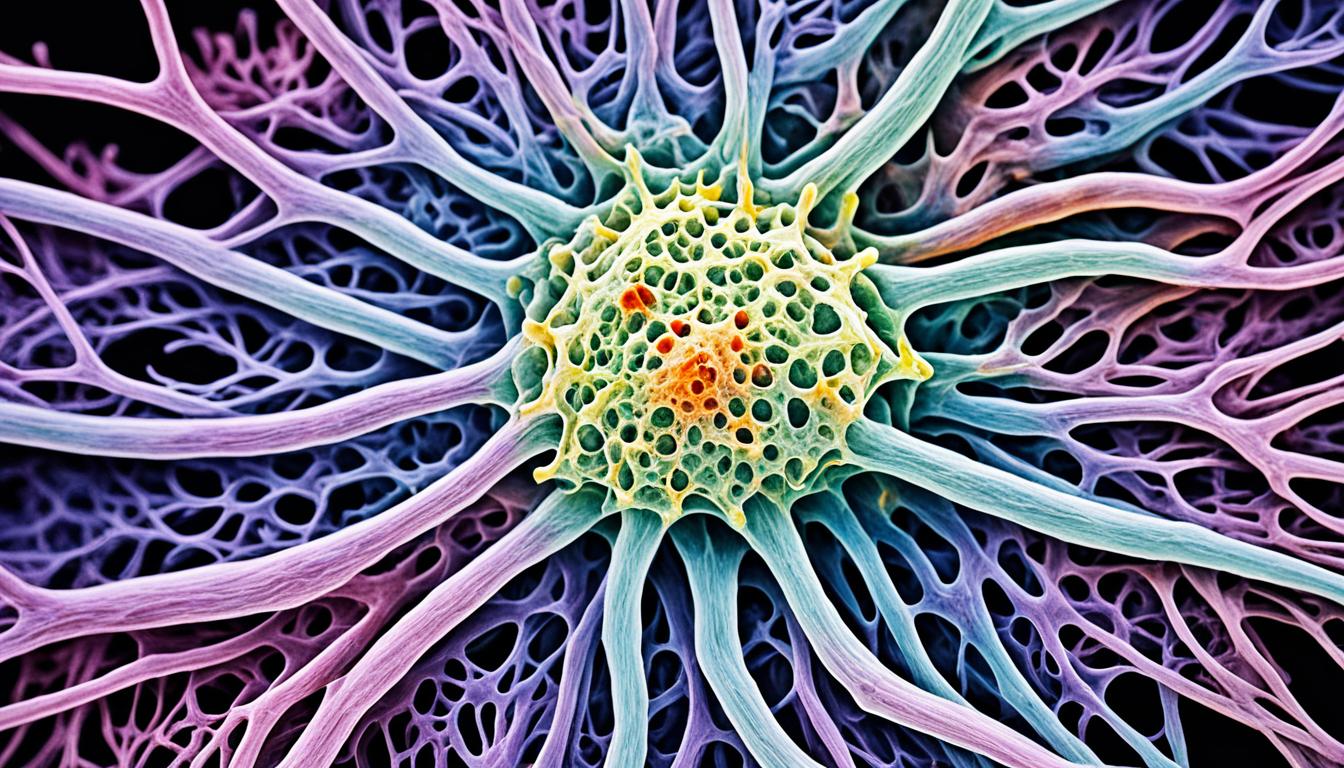Peripheral nerve tumors are growths on the nerves outside the brain and spinal cord. These tumors may be benign or cancerous. They can cause nerve damage and impact muscle control. The common types are neurofibroma, schwannoma, and perineurioma.
Symptoms of these tumors can include pain, tingling, numbness, and muscle weakness. The main cause is usually not clear, though there may be a genetic link. Diagnosing these tumors involves a check-up, imaging tests, and sometimes a small surgery to check the tissue.
Treating peripheral nerve tumors depends on factors like the tumor’s size, where it’s located, and how fast it’s growing. Doctors usually aim to surgically remove the tumor. They might also use radiation or chemo. An exciting new treatment method is stem cell therapy.
Key Takeaways:
- Peripheral nerve tumors can be benign or cancerous and can cause symptoms such as pain, tingling, numbness, weakness, and swelling.
- Neurofibroma, schwannoma, and perineurioma are the most common types of peripheral nerve tumors.
- Diagnosis typically involves a physical examination, imaging tests, and a surgical biopsy to confirm the diagnosis.
- Treatment options for peripheral nerve tumors include surgery, radiation therapy, chemotherapy, and the innovative approach of stem cell therapy.
- Managing peripheral nerve tumors requires a personalized approach based on individual factors such as the tumor’s size, location, type, and growth rate.
Types of Peripheral Nerve Tumors
There are various types of peripheral nerve tumors, such as neurofibroma, schwannoma, and perineurioma. Each type comes with its own unique features and can show different symptoms.
Neurofibroma: These tumors grow at the center of a nerve. They are linked to certain genetic problems. Neurofibromas can lead to pain, numbness, weakness, and swelling. They affect both peripheral and central nerves.
Schwannoma: Schwannomas are common benign tumors. They form in adults. Schwannomas come from Schwann cells, which protect nerves with a myelin sheath. Depending on where they are, they cause symptoms like pain, tingling, and muscle weakness.
Perineurioma: Perineuriomas are rare and form from perineurial cells that cover nerves. They can grow inside or outside nerves and mostly grow slowly. They may cause pain, numbness, weakness, and swelling.
Peripheral nerve tumors can really affect someone’s life. They can cause pain, change how we feel things, and hurt movement. It’s key to spot them early and treat them right.
Knowing about the different peripheral nerve tumors is important for finding the right treatment. Each type might need a different plan, depending on where it is and if it could be cancer. Next, we’ll look into diagnosis and treatment for these tumors.
Diagnosis and Treatment of Peripheral Nerve Tumors
Diagnosing peripheral nerve tumors requires a thorough approach. It aims to pinpoint the tumor’s presence and type. Doctors typically use physical exams, imaging, and biopsies to confirm.
Imaging tests, like MRI and CT scans, offer detailed looks at the tumor and its surroundings. They help know the tumor’s size, where it is, and its features. This information is key for proper diagnosis.
A biopsy is often done by taking a tiny piece of the tumor for closer study. Looking at this piece under a microscope is crucial. It helps determine the exact type of nerve tumor present.
After the diagnosis, the treatment plan for peripheral nerve tumors is carefully tailored. The strategy is based on the tumor’s size, position, type, and how fast it’s growing.
If the tumor is small and growing slowly, the plan might be to simply monitor it. Doctors and patients watch how it behaves over time. They step in if it starts to cause problems.
Surgery is the main choice for treating these tumors if they need removal. The surgery’s goal is to take out as much as possible without affecting nerve function. How much they remove depends on many factors.
For tumors that surgery can’t fully address, radiation therapy or chemo might help. Radiation uses powerful beams to attack the tumor cells. Chemo involves drugs that can either kill or slow the cancer cells.
Stem cell therapy is a new option that shows a lot of promise. It works on repairing the nerves damaged by the tumor. This could significantly boost recovery and improve the patient’s health in the long run.
| Treatment Options | Description |
|---|---|
| Surgery | Removal of the tumor through surgical intervention, preserving nerve function. |
| Radiation Therapy | Utilizing high-energy beams to destroy or shrink tumor cells. |
| Chemotherapy | Administering medication to kill or halt the growth of cancerous cells. |
| Stem Cell Therapy | Applying regenerative medicine techniques to repair damaged nerves and enhance recovery. |
Conclusion
Peripheral nerve tumors are uncommon but can have serious effects. They may bring pain, numbness, weakness, and swelling. To diagnose these, doctors use a mix of physical exams, MRI or CT scans, and a small tissue sample (biopsy).
Treatment options depend on the person’s situation. Often, surgery is used to take out these tumors and reduce symptoms. Doctors might also recommend radiation or chemo to stop the tumor from growing back.
In recent times, a new method called stem cell therapy has come into the picture. It offers new hope for treating these nerve tumors. As technology and research progress, more effective ways to deal with peripheral nerve tumors are becoming available.

